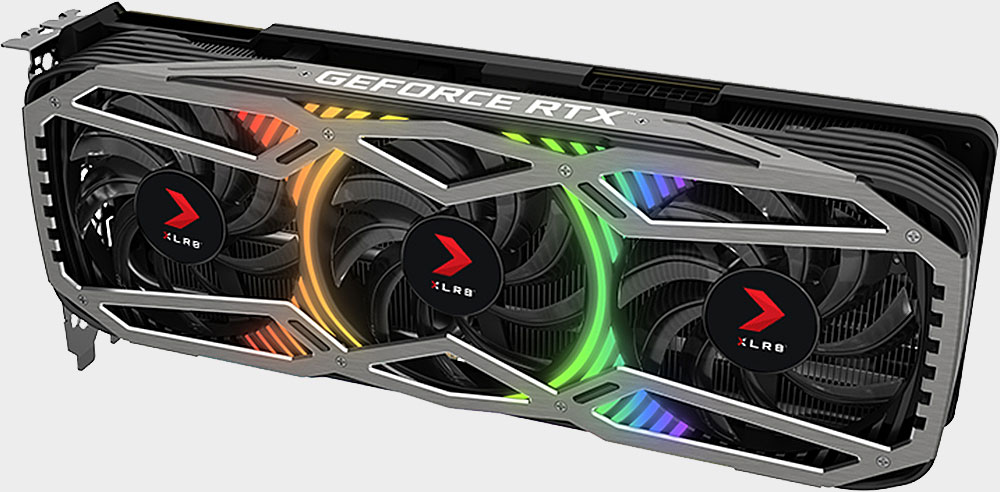This crypto-mining farm with 78 GeForce RTX 3080 GPUs likely rakes in $154,000 per year
Even at inflated third-party selling prices for the GPUs, the miner will still turn a profit in around 10 months.

It seems only fitting to end 2020 on a depressing note, and to that end, a cryptocurrency miner living in Las Vegas has apparently managed to procure dozens of PNY brand GeForce RTX 3080 cards to mine Ethereum. How in the world he managed to obtain so many elusive cards is beyond me, but even if he paid second-hand prices, it will be a profitable operation before the end of next year.
Nvidia kicked off its Ampere party in the consumer sector with the GeForce RTX 3080, which released to retail on September 17 for $699 (MSRP). And by "released to retail," I mean it was available for all of a nanosecond before it sold out everywhere. Since then, Nvidia has launched three more models—GeForce RTX 3090 ($1,499), GeForce RTX 3070 ($499), and GeForce RTX 3060 Ti ($399), in that order—and those sold out immediately as well.
This has made it frustrating for PC gamers in need or want of an upgrade. Adding to the ire is the fact that consumers have been going up against scripted bots, making it even more difficult to actually buy a GeForce RTX 30 series card (or an AMD Radeon RX 6000 series GPU or Ryzen 5000 series CPU, as it were) at regular pricing.
Throw cryptocurrency mining into the mix and, well, is anyone really surprised? According to TechArp, a fellow named Simon Byrne is running an Ethereum mining operation with 78 GeForce RTX 3080 graphics cards, all arranged neatly on an open rack. That is, unless the pictures are Photoshopped—I have not been able to track down this Simon Byrne, so there's a chance it's a bunch of malarkey, just like the supposedly lost and found shipment of 500,000 GeForce RTX 30 series cards.
If this is a real operation, however, Simon Byrne stands to make a hefty profit. TechArp ran some numbers and they go like this. Suppose he paid second-hand seller pricing of $1,199 per card. That works out to $93,522, which we can round up to an even $100,000 to factor in the cost of the power supply units and the housing rack.
The average cost of electricity in Las Vegas for a commercial customer is 8.43 cents per kWh. That works out to $1,444 per month. Now raise that 50 percent to $2,166 to account for the cost of AC cooling. So over the course of a year, he'd be paying $25,992 in electricity and cooling. Add in the cost of the hardware, and his first-year expenses are $125,992.
Now let's shift to the mining haul. Each card has a hash rate of 83.57 MH/s. That works out to around $165 worth of Ethereum (0.22236870 ETH) each month. Multiply that by 78 and you arrive at 17.3447586 ETH, valued at $12,840 per month, or $154,080 per year.
Keep up to date with the most important stories and the best deals, as picked by the PC Gamer team.
Based on that math, Simon Byrne and his 78 GPUs stand to profit $28,088 in the first year, and $125,088 annually each year thereafter (unless I messed up the math somewhere).
Of course, this assumes a stable price for Ethereum. Cryptocurrency values fluctuate, sometimes dramatically, so this is more of a rough estimate based on current pricing. Still, it's interesting. And depressing, from a consumer gaming standpoint.
Fortunately, the shortage of GPUs will not last forever. During a third-quarter earnings call last month, Nvidia CFO Colette Kress noted that "given industry-wide capacity constraints and long cycle times, it may take a few more months for product available to catch up with demand." So hopefully this situation will not extend past the first quarter of 2021.
Paul has been playing PC games and raking his knuckles on computer hardware since the Commodore 64. He does not have any tattoos, but thinks it would be cool to get one that reads LOAD"*",8,1. In his off time, he rides motorcycles and wrestles alligators (only one of those is true).


